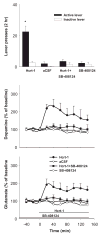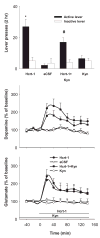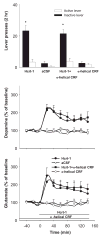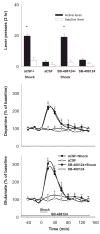Reinstatement of cocaine seeking by hypocretin (orexin) in the ventral tegmental area: independence from the local corticotropin-releasing factor network
- PMID: 19251246
- PMCID: PMC2705875
- DOI: 10.1016/j.biopsych.2009.01.018
Reinstatement of cocaine seeking by hypocretin (orexin) in the ventral tegmental area: independence from the local corticotropin-releasing factor network
Abstract
Background: Hypocretin (Hcrt), an arousal- and feeding-associated peptide, is expressed in lateral hypothalamic neurons that project to the ventral tegmental area (VTA). Intra-VTA Hcrt reinstates morphine-conditioned place preferences, and intracerebroventricular and intra-VTA corticotropin-releasing factor (CRF) reinstate cocaine seeking. Each is presumed to act, at least in part, through actions local to the VTA. Here, we examined the possibility that VTA perfusion of Hcrt reinstates cocaine seeking and, if so, whether it does so through the VTA mechanism that is implicated in reinstatement by CRF.
Methods: Rats were trained to lever-press for intravenous cocaine (2 weeks) and then underwent extinction training (saline substituted for cocaine: 3 weeks). Reinstatement behavior was tested and VTA dialysates were collected and assayed for glutamate or dopamine following footshock or perfusion of Hcrt or CRF, with or without Hcrt or CRF antagonists, into the VTA.
Results: Ventral tegmental area perfusion of Hcrt-1 or footshock stress reinstated cocaine seeking and caused release of VTA glutamate and dopamine. The effects of Hcrt-1 were blocked by a selective Hcrt-1 antagonist, but not a CRF antagonist, and were not mimicked by Hcrt-2. The Hcrt-1 antagonist did not block CRF-dependent footshock-induced reinstatement or glutamate or dopamine release. The behavioral and neurochemical effects of Hcrt-1 were attenuated but not blocked by kynurenic acid, an ionotropic glutamate antagonist that blocks footshock-induced reinstatement and glutamate release.
Conclusions: While Hcrt and CRF are known to interact in some area of the brain, in the VTA proper they appear to have largely independent actions on the mesolimbic dopamine mechanisms of cocaine seeking.
Figures




Similar articles
-
Stress-induced relapse to cocaine seeking: roles for the CRF(2) receptor and CRF-binding protein in the ventral tegmental area of the rat.Psychopharmacology (Berl). 2007 Aug;193(2):283-94. doi: 10.1007/s00213-007-0782-3. Epub 2007 Apr 17. Psychopharmacology (Berl). 2007. PMID: 17437087
-
Interactions between VTA orexin and glutamate in cue-induced reinstatement of cocaine seeking in rats.Psychopharmacology (Berl). 2013 Apr;226(4):687-98. doi: 10.1007/s00213-012-2681-5. Epub 2012 Mar 13. Psychopharmacology (Berl). 2013. PMID: 22411428 Free PMC article.
-
Augmented cocaine seeking in response to stress or CRF delivered into the ventral tegmental area following long-access self-administration is mediated by CRF receptor type 1 but not CRF receptor type 2.J Neurosci. 2011 Aug 3;31(31):11396-403. doi: 10.1523/JNEUROSCI.1393-11.2011. J Neurosci. 2011. PMID: 21813699 Free PMC article.
-
A ventral tegmental CRF-glutamate-dopamine interaction in addiction.Brain Res. 2010 Feb 16;1314:38-43. doi: 10.1016/j.brainres.2009.09.101. Epub 2009 Oct 1. Brain Res. 2010. PMID: 19800323 Free PMC article. Review.
-
Lateral hypothalamic orexin/hypocretin neurons: A role in reward-seeking and addiction.Brain Res. 2010 Feb 16;1314:74-90. doi: 10.1016/j.brainres.2009.09.106. Epub 2009 Oct 6. Brain Res. 2010. PMID: 19815001 Free PMC article. Review.
Cited by
-
Differential effects of acute and chronic ethanol exposure on orexin expression in the perifornical lateral hypothalamus.Alcohol Clin Exp Res. 2010 May;34(5):886-96. doi: 10.1111/j.1530-0277.2010.01161.x. Epub 2010 Mar 10. Alcohol Clin Exp Res. 2010. PMID: 20331576 Free PMC article.
-
A Role for Neuropeptide S in Alcohol and Cocaine Seeking.Pharmaceuticals (Basel). 2022 Jun 27;15(7):800. doi: 10.3390/ph15070800. Pharmaceuticals (Basel). 2022. PMID: 35890099 Free PMC article. Review.
-
Orexin 1 receptor antagonists in compulsive behavior and anxiety: possible therapeutic use.Front Neurosci. 2014 Feb 13;8:26. doi: 10.3389/fnins.2014.00026. eCollection 2014. Front Neurosci. 2014. PMID: 24592206 Free PMC article. Review.
-
Different levels in orexin concentrations and risk factors associated with higher orexin levels: comparison between detoxified opiate and methamphetamine addicts in 5 Chinese cities.Biomed Res Int. 2013;2013:282641. doi: 10.1155/2013/282641. Epub 2013 Sep 12. Biomed Res Int. 2013. PMID: 24102051 Free PMC article.
-
The Role of Orexins/Hypocretins in Alcohol Use and Abuse.Curr Top Behav Neurosci. 2017;33:221-246. doi: 10.1007/7854_2016_55. Curr Top Behav Neurosci. 2017. PMID: 27909991 Review.
References
-
- Sakurai T, Amemiya A, Ishii M, Matsuzaki I, Chemelli RM, Tanaka H, et al. Hypocretins and hypocretin receptors: a family of hypothalamic neuropeptides and G protein-coupled receptors that regulate feeding behavior. Cell. 1998;92:573–585. - PubMed
-
- Sutcliffe JG, de Lecea L. The hypocretins: setting the arousal threshold. Nat Rev Neurosci. 2002;3:339–349. - PubMed
-
- Taheri S, Zeitzer JM, Mignot E. The role of hypocretins (orexins) in sleep regulation and narcolepsy. Annu Rev Neurosci. 2002;25:283–313. - PubMed
Publication types
MeSH terms
Substances
Grants and funding
LinkOut - more resources
Full Text Sources

